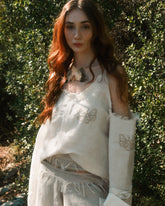PEACE SILK AND WILD SILK: TWO FACES OF SUSTAINABLE FASHION

In the world of sustainable and ethical fashion, the concepts of "Peace Silk" and "Wild Silk" are gaining increasing importance. In traditional silk production, silkworms are boiled alive in their cocoons to extract the silk threads. This process leads to the death of millions of silkworms. However, in the non-violent silk production methods that we will discuss in detail below, the silkworms are allowed to emerge naturally from their cocoons, allowing their life cycle to continue.
But what are the differences between these two terms, and which one offers a more sustainable option? In this article, we will explore these questions and provide detailed information about both Peace Silk and Wild Silk.
What is Peace Silk?
Ahimsa silk is the most well-known type of non-violent silk. "Ahimsa" is a Sanskrit term meaning "non-violence," and in this production method, silkworms are allowed to emerge naturally from their cocoons. This method represents an animal-friendly and ethical production process. The most renowned silk in this type of production, named after the silkworm species, is Eri Silk. In Eri silk production, silkworms are left to follow their natural cycles and silk is collected after they have emerged from their cocoons. Eri silk is known for its cotton-like texture and durability, making it a high-quality silk.
Benefits of Peace Silk Production
- Animal Welfare: Silkworms can complete their natural life cycle.
- Environmental Sustainability: It consumes less energy and water compared to traditional silk production.
- High Quality: Naturally obtained fibers are longer and stronger, enhancing the quality of the silk.
What is Wild Silk?
Wild Silk is derived from silkworms that live freely in nature. These silkworms are allowed to live in their natural habitats, and the silk is collected after they emerge naturally from their cocoons. Wild Silk is known for its natural colors and textures, with Tussar Silk and Muga Silk being two significant types in this category.
Types of Wild Silk
- Tussar Silk: Harvested from wild silkworms in India and known for its natural golden color.
- Muga Silk: Native to the Assam region and renowned for its distinctive golden yellow color.
- Forest Silk:Forest silk refers to silk obtained from silkworms living mainly in forested areas. This type of silk is usually categorised as ‘wild silk’ because it is obtained from silkworms living freely in natural habitats. Forest silk is a precious type of wild silk, obtained more specifically from silkworms living in forested areas.
Benefits of Wild Silk
- Natural and Ethical: Silkworms complete their natural life cycle.
- Eco-Friendly: Harvested in natural habitats, maintaining the ecological balance.
- Unique Aesthetic: Each product is unique due to the natural color and texture variations.
Differences Between Peace Silk and Wild Silk
Production Process
Peace Silk is produced by allowing silkworms to emerge from their cocoons in controlled environments, whereas Wild Silk is harvested from silkworms living freely in nature. In Peace Silk production, silkworms are usually farmed, making the process more controlled. Wild Silk, on the other hand, is entirely collected from natural environments, giving it a unique characteristic.
Environmental Impact
Both types of silk offer environmental sustainability benefits. Peace Silk production, while done in agricultural settings, has a lower environmental impact compared to traditional silk production. Wild Silk is entirely harvested from natural habitats, preserving the ecosystem.
Applications
Peace Silk is often preferred in luxury fashion and textile products, while Wild Silk is used in more rustic and natural-looking products. Both types of silk are of high quality and are favored by ethical fashion enthusiasts.
Conclusion
Peace Silk and Wild Silk hold significant places in the world of sustainable and ethical fashion. Both types of silk respect animal welfare and have environmentally sustainable production processes. As consumers, by choosing these products, we can make environmentally conscious choices and support ethical fashion.
Our goal is not to position these products as commercial options or trends for the sake of sales, but to move together towards a genuine, sincere, conscious, and sustainable fashion world. If you have any questions or experiences you would like to share on this topic, please share them with us in the comments section. Together, let's create a more conscious and sustainable fashion world.








